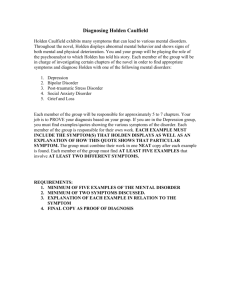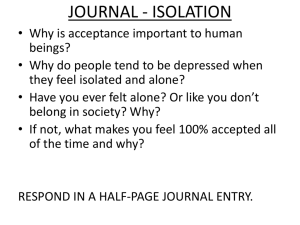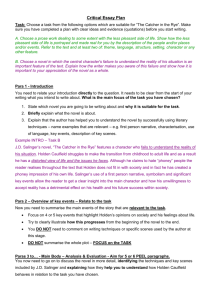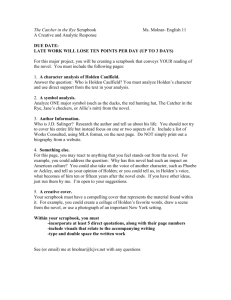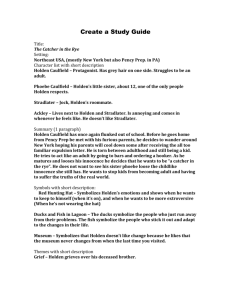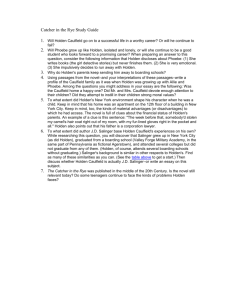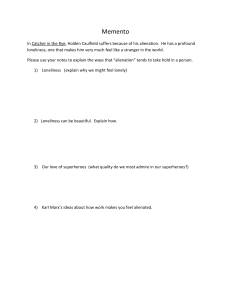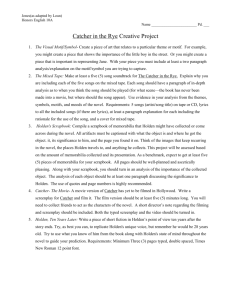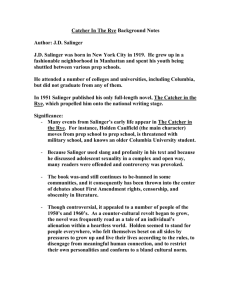The Catcher in the Rye by JD Salinger
advertisement
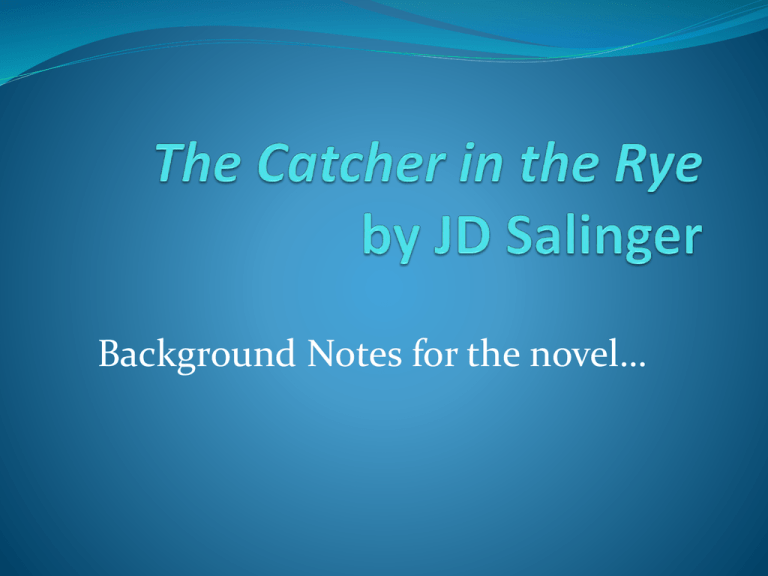
Background Notes for the novel… a. Point of View: First–person narrative, (I) b. Stream of Consciousness: Reveals Holden’s inner thoughts, emotions & memories. c. Confessional: Tone is confidential & intimate. d. Dialogue: Holden repeats conversations. e. Flashbacks: Contains memories of earlier events, told in retrospect. f. Colloquial (local) Language & Slang: Holden speaks in a language that is real; it is authentic for 1950s. g. Plot Structure = Episodic: Holden re-lives the 48-hour period following his expulsion from Pencey Prep School. h. Frame Novel: A story within a story. Inserting a story within the body of a larger story that encompasses the other one. i. Genres: 1. bildungsroman: A coming-of-age story. A novel in which an adolescent protagonist comes to adulthood by a process of experience and disillusionment. This character loses his or her innocence, discovers that previous preconceptions are false, or has the security of childhood torn away, but usually matures and strengthens by this process. i. Genres: 2. Picaresque: A chronicle, usually autobiographical, of the life story of a rascal of low degree engaged in menial tasks and making his living through his wits. The picaro (protagonist) provides satire of the social classes through various pranks and predicaments and by his association with random characters. Romantic and an adventure story, the picaresque novel is marked by realism in petty detail and by uninhibited expression. a. Pragamatist: 1. Logical, reasons to solve problems 2. Practical approach to life 3. Factual, not idealistic 4. Characters: Sally Hayes, Carl Luce b. Realist: 1. Sees the world as it is 2. Realizes the world & humanity have faults & flaws 3. Characters: Mr. Spenser, Robert Ackley, the two Nuns in NYC c. Materialist: 1. Values materialistic possessions & money; greedy? 2. Characters: D.B. Caulfield, Ward Stradlater, Dick Slagle d. Romantic Idealist: 1. Sees the world as he/she wants to see it, not as it truly is. 2. Romantic idealism is a naive, miscalculated dream of a perfect world without factoring in the flaws of the real world. 3. Character: Holden Caulfield e. Existentialist: 1. Existentialism: A 20th Century philosophy arguing that human beings are cursed with absolute free will in a purposeless universe. 2. They believe people are free & therefore responsible for what they make of themselves; individuals must fashion their own sense of meaning in life instead of relying on religious, political, and social conventions. 3. With this responsibility comes profound anguish & dread 4. Character: Holden Caulfield f. Pacifist: 1. One who opposes war & the use of military force. 2. Character: Holden Caulfield a. Hero: Protagonist: 1. Central character in a work of fiction. 2. Term applies to characters who are the focus of the reader’s attention without reference to moral superiority of one character over another (doesn’t have to be a “good guy’). 3. Examples: John Proctor, the Godfather, Walter White b. Tragic Hero: 1. A protagonist in a drama or novel who has a flaw, error or defect that is the cause of his/her downfall. 2. Examples: Romeo & Juliet, John Proctor, Walter White c. Anti-Hero: 1. Protagonist whose distinctive qualities are directly opposite of the traditional hero. 2. This opposition does not necessarily imply that the character is evil or bad. 3. This often reflects the author’s belief that modern life no longer tolerates or produces individuals capable of classic & genuine heroism. 4. Examples: Clark Kent, Peter in Office Space, Walter White, Dexter, Huckleberry Finn, Holden Caulfield d. Unreliable Narrator: 1. Narrator who is not always perceptive about what is happening in the plot, or someone who is deliberately lying. 2. Consider as you read The Catcher in the Rye: Is Holden an unreliable narrator? Can you trust him? 3. Examples: Scout in To Kill A Mockingbird, Montresor in The Cask of Amontillado, Narrator in Fight Club, Huckleberry Finn in The Adventures of Huckleberry Finn Definition: Repeated symbols or patterns in literature. a. phoniness/duplicity b. alienation/isolation c. failure to communicate/be understood d. concerns with death e. resistance to change f. preference for remaining a child g. concerns regarding lack of validation h. masking identity i. religion j. feeling of falling/disappearing k. guilt Definition: A word, character, place or object that means something significant beyond its literal level. a. red hunting hat b. Allie’s baseball mitt c. ducks/pond d. snow e. carousel f. museum a. Critics praise the novel for its… 1. realism in the use of language & dialogue. 2. social criticism. 3. presentation of real problems of adolescence. 4. portrayal of the innocence of childhood. 5. quest for truth. 6. emphasis on individual discovery & growth. b. Others have tried to ban the novel for its.. 1. use of slang (1950s). 2. use of profanity. 3. protagonist as an inappropriate role model. 4. sleazy scenes/situations. 5. lack of moral instruction.

